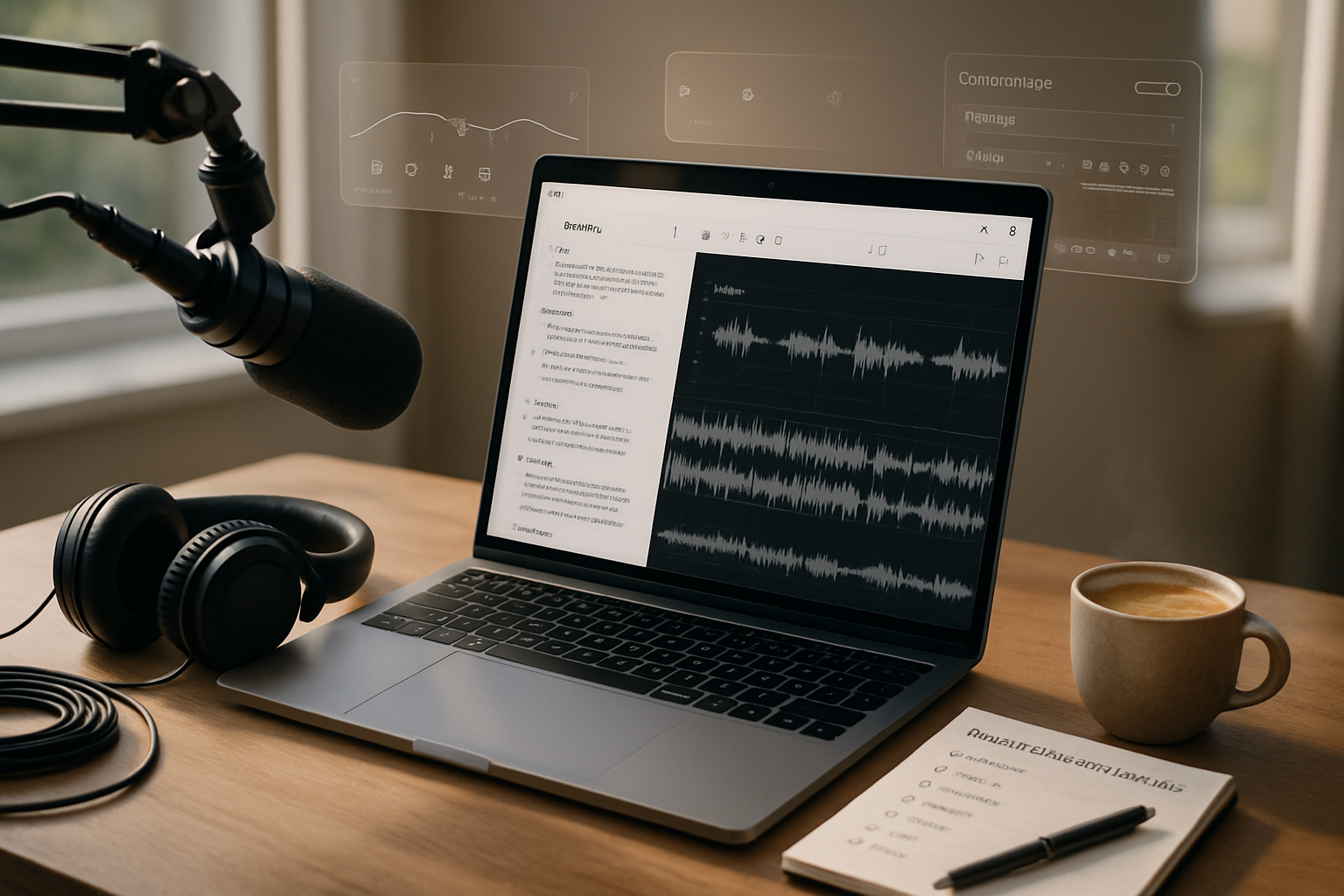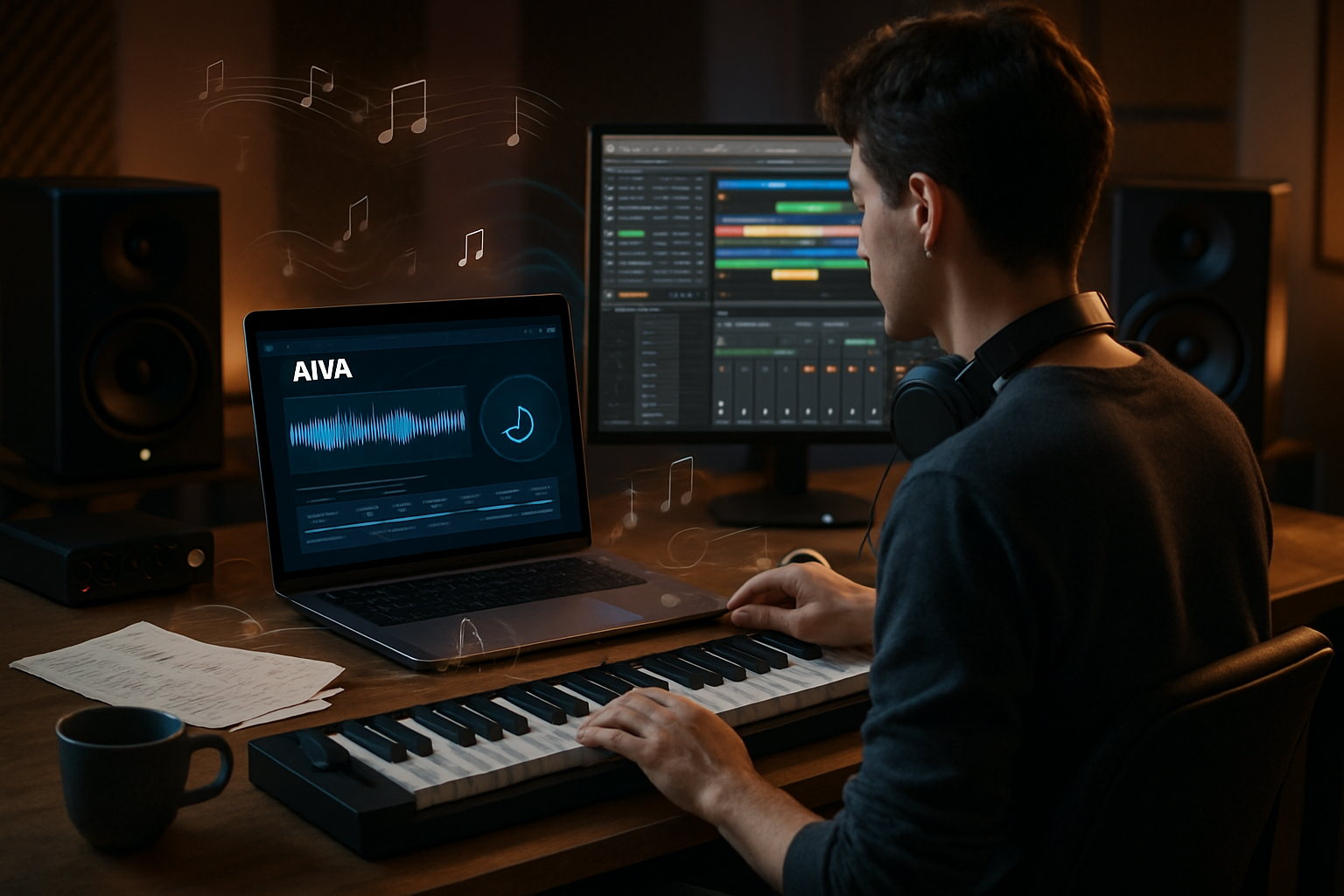· creativity · 6 min read
10 Descript Tips to Enhance Your Podcast Editing Workflow
Transform your podcast workflow with 10 advanced Descript tips - save hours, improve audio quality, and ship consistent episodes faster using transcript-first editing, Studio Sound, Overdub, templates, and export automation.

Hook - get to a publish-ready episode faster. Much faster.
By the end of this article you’ll have ten practical, advanced Descript techniques that together shave hours off editing, improve audio quality, and make your episodes consistent at scale.
Why Descript? Because it flips editing from waveform fiddling to text-powered speed, while still giving you pro audio tools when you need them. Short cuts for huge wins. Long-term structure for ongoing speed.
Quick roadmap (what you’ll be able to do)
- Convert raw audio to an editable transcript and remove filler words in minutes.
- Apply Studio Sound and a consistent processing chain to lift audio quality quickly.
- Use Overdub and templates to fix mistakes and automate intros/outros.
- Export optimized files and publish directly to hosting with reproducible settings.
1) Start transcript-first - and instrument your import
Why this matters: cleaning audio is faster when you can read and edit it.
How to do it:
- Import all tracks into a single Descript project and run automatic transcription immediately. The text view makes large structural edits trivial - delete a paragraph in the transcript and the corresponding audio is removed.
- Turn on speaker detection and quickly assign speaker labels. Fix mislabels in the transcript - this keeps later edits clean.
- Pro tip - use the transcript search to find all instances of a guest’s name or a recurring phrase for fast consistency checks.
Reference: Descript features and transcription overview: https://www.descript.com/features and https://help.descript.com/en/.
2) Use Studio Sound strategically - but keep a raw backup
Why this matters: Studio Sound can dramatically reduce room reflections and noise, getting you close to broadcast quality with minimal effort.
How to do it:
- Duplicate your sequence or export a raw backup before applying Studio Sound. Always keep one untouched copy for future reprocessing.
- Apply Studio Sound at the clip or composition level depending on whether speakers have different room profiles.
- If results seem “over-processed,” reduce Studio Sound strength or follow up with manual EQ for naturalness.
Reference: Studio Sound documentation: https://help.descript.com/en/.
3) Automate filler-word removal - then audit
Why this matters: filler words (uh, um, you know) eat time and attention. Descript automates most of the work.
How to do it:
- Use the built-in Remove Filler Words feature to strip common fillers across the whole transcript in one click.
- Configure custom filler words (industry-specific verbal ticks) and re-run.
- Always listen to the automated edits in context; remove only where speech flow isn’t harmed.
Reference: Tools for removing filler words: https://help.descript.com/en/.
4) Overdub for surgical fixes - ethically and sparingly
Why this matters: a 3-second overdub can replace a re-recorded line without scheduling the guest again.
How to do it:
- Create your voice profile (if you host multiple shows or need a safety net). Use Overdub only for minor corrections and with consent when other voices are involved.
- Prefer text-to-speech fixes for simple word swaps. For longer content, record natural ADR if possible.
- Label overdub clips clearly in your timeline so future editors know what’s synthetic.
Reference: Overdub overview: https://help.descript.com/en/.
5) Build and use episode templates and compositions
Why this matters: templates = consistency + massive time savings across episodes.
How to do it:
- Create a composition that contains your intro, ad slots, music beds, and standard chapter markers. Save it as a project template.
- For serialized shows, include a named track stack (e.g., Host, Guest, Music, Ads) so imports map consistently.
- Use editable placeholders for dynamic content (guest names, episode numbers) so you don’t reassemble intros each week.
Reference: Composition and templates: https://help.descript.com/en/.
6) Master keyboard shortcuts and text-first editing techniques
Why this matters: editing via text is faster than scrubbing waveforms - but only if you’re fluent.
High-impact shortcuts and practices:
- Delete words/phrases directly in the transcript to remove audio. Fast.
- Use Z / Undo aggressively; Descript’s history is robust.
- Learn the shortcuts for split, ripple delete, and playback controls so your hands never leave the keyboard.
Quick cheat-sheet example:
- Split clip - Command/Ctrl + K
- Play/Stop - Space
- Ripple delete - Select text/audio, hit Delete
Check Descript’s shortcut list in-app and customize for your workflow.
7) Use markers, speaker labels, and groups for assembly speed
Why this matters: large interviews become manageable and repeatable when segmented.
How to do it:
- Add chapter markers for topic changes during recording (either live or during a quick skim). These become your edit checklist.
- Group and color-code clips for segments (Intro, Interview Part 1, AdRead, Outro). Use grouping to move whole segments without losing timing.
- Use speaker labels to batch-apply processing (e.g., apply a de-esser only to the host track).
8) Apply consistent audio chains (EQ → Compression → Limiter)
Why this matters: a predictable processing chain gets you broadcast-ready sound every time.
Recommended order and settings to start with:
- High-pass filter at ~80 Hz to remove rumble.
- Gentle EQ cut around boxy frequencies (200–500 Hz) if needed.
- Light compression (ratio 3:1, moderate attack and release) to even out levels.
- De-esser on sibilant voices.
- Normalize peak to -1 dBFS and apply a final limiter for output safety.
How to apply across episodes:
- Save effect chains as presets and apply them to tracks or the whole composition.
- Use clip gain for large level differences before applying global processors.
9) Export, publish, and archive with repeatable presets
Why this matters: consistent exports prevent gateway issues with hosts and keep your production predictable.
Best practices:
- Primary deliverable - MP3 128–192 kbps constant bitrate for hosting; WAV 48 kHz 24-bit for archive/master files.
- Use Descript’s composition export presets and save custom presets for platform-specific needs (Apple Podcasts, YouTube audio, Spotify).
- Automate publishing with Descript’s built-in publishing options or via Zapier to push episode metadata to your podcast host.
Reference: Export & publishing in Descript: https://help.descript.com/en/.
10) Collaborate, comment, version and automate
Why this matters: a single editor can’t scale a podcast alone. Collaboration shortcuts drive speed and quality.
How to do it:
- Use comments to leave time-stamped notes for co-editors and producers. Resolve comments to track progress.
- Use version history to snapshot major edits so you can restore earlier takes if needed.
- Automate repetitive tasks (e.g., transcribe + start template) with Zapier or team workflow tools.
Fast 30-minute edit workflow (put the tips together)
- Import recorded tracks, run transcription, assign speaker labels (5 minutes).
- Remove filler words and scan for obvious flubs (5 minutes).
- Make large structural edits in transcript (delete tangents, reorder segments) (8 minutes).
- Apply Studio Sound to the composition copy and run the preset processing chain (5 minutes).
- Add intro/outro template, finalize levels, export MP3 and WAV master (5 minutes).
- Publish using preset and add show notes metadata (2 minutes).
You can’t avoid careful listening entirely. But this sequence gets you from raw to publishable in a focused half-hour for many interviews.
Troubleshooting common pitfalls
- Over-processed audio after Studio Sound - dial back strength, or apply Studio Sound only to problematic clips.
- Transcription errors for technical vocabulary - add custom vocabulary entries or correct the transcript and save that text as a reference for future sessions.
- Over-reliance on Overdub - mark synthetic lines and maintain ethical transparency when necessary.
Checklist to implement today
- Build one episode template in Descript.
- Create and save an effect chain preset (EQ → Compressor → Limiter).
- Add 5 custom filler words and enable auto-removal.
- Practice a 30-minute edit using the fast workflow above.
Closing - the real payoff
The individual tips save minutes. Put together, they save hours - every episode. You’ll get cleaner audio, fewer re-records, and a repeatable process that scales. Build templates. Trust the transcript view. Use Studio Sound and Overdub intelligently. Get comfortable automating exports. Do this, and publishing will stop being the bottleneck. Your listeners will hear the difference.
References
- Descript features and help: https://www.descript.com/features and https://help.descript.com/en/



